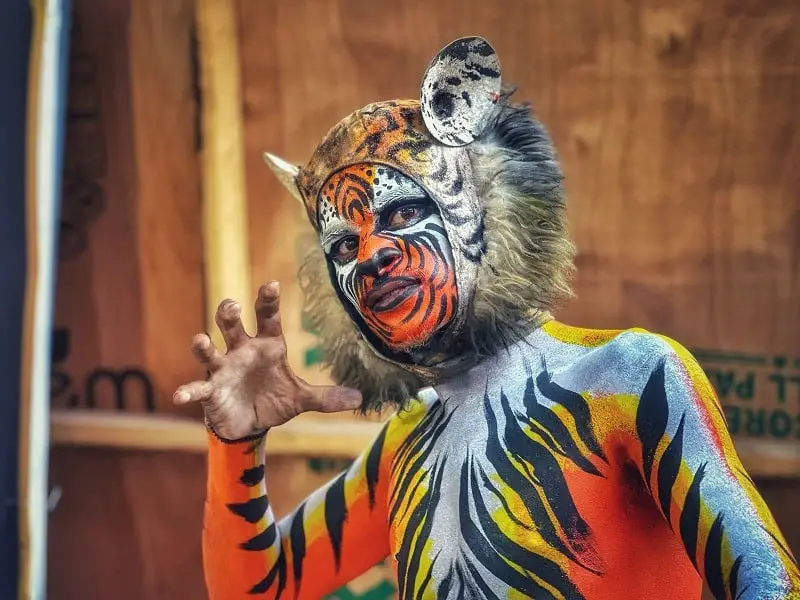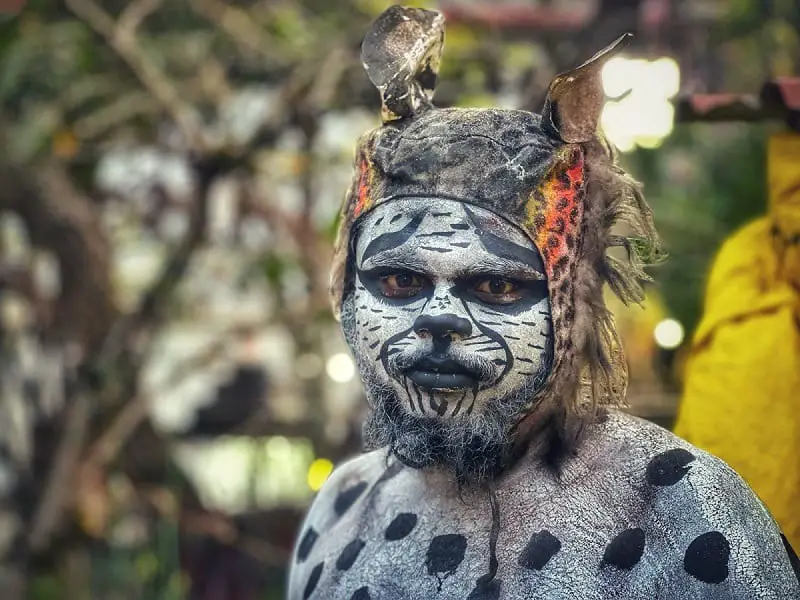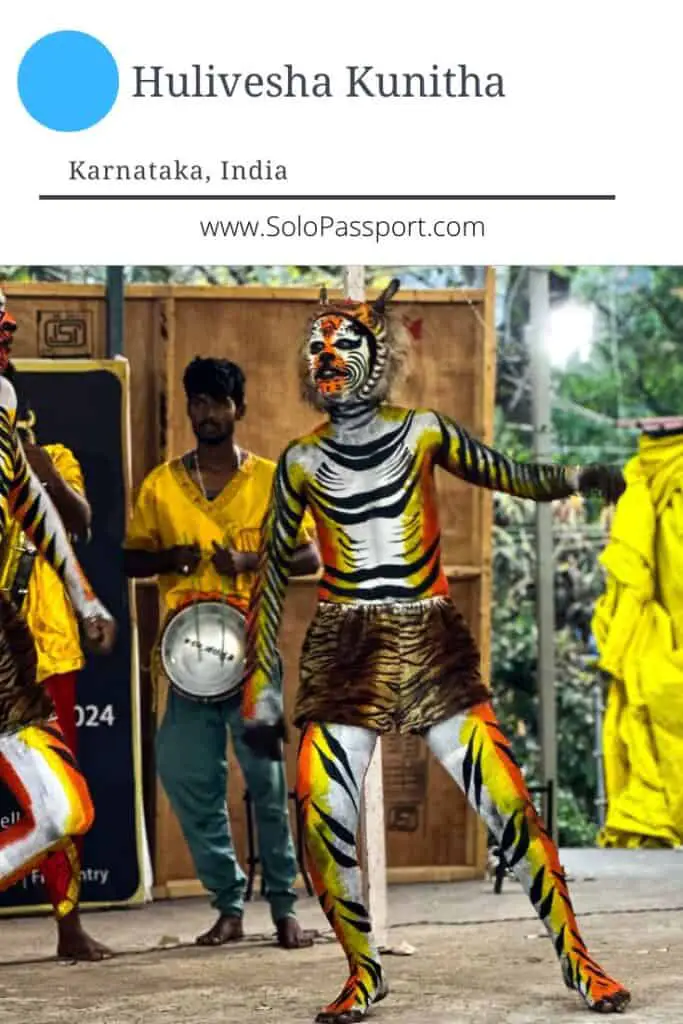Discover the captivating artistry of the richly adorned Hulivesha Dance, an indigenous performance in Karnataka. Recently, I had the enriching experience of witnessing a live rendition of the Hulivesha Dance at the esteemed Karnataka Chitrakala Parishad.
Often overshadowed by the renowned Yakshagana, Hulivesha and Dollu Kunitha hold prestige in the state’s culture. The performance was nothing short of mesmerizing, brimming with vibrancy and exuding boundless energy.
As the dancers moved gracefully and precisely, I knew this was a cherished moment. Amidst the rhythmic beats and elaborate costumes, I was immersed in the beauty of this traditional art form. Indeed, it was an unforgettable spectacle that left an indelible impression on my senses.
This article may contain affiliate links. For complete information, please see our affiliate disclaimer here.
Bengaluru Travel Resources
Don’t have the time to read the complete post? Here are some useful links for your bookings:
Cheap Flight Bookings? Use Skyscanner
Good stay and accommodation? Use Agoda or Stay22
Hostels? Use HostelWorld
Comprehensive Travel Insurance? Use SafetyWing
Tours and Activity Bookings? Use Viator, GetYourGuide or TripAdvisor
Useful Blog Posts
Things to Know Before Visiting Bangalore
Discover Kempegowda International Airport
Best Hotels in Bangalore for Family Holidays
Review of Taj Westend Bangalore (5-Star Hotel)
Review of Jayamahal Palace Hotel (4-Star Hotel)
Transport in Bangalore: Getting Around the City
One-Day Itinerary for Bangalore
2 Days in Bangalore
3 Days in Bangalore
5 Days in Bangalore
Best Area to Stay in Bangalore
About Hulivesha Dance or Hulivesha Kunitha
Originating from Karnataka, the Hulivesha Dance, or Hulivesha Kunitha, is a dynamic expression of the state’s cultural legacy. Hulivesha is a tribute to Goddess Durga, whose mooshika vahana (an animal that carries the God) is the tiger. Recognised as ‘Tiger Dance’ or ‘Puli Vesha,’ this traditional form flourishes predominantly along the coastal regions, notably during the festive fervour of Dusherra or Navratri.
Groups of young men assemble into troops of five to ten members or more. Three to five males are painted and adorned within these troops to resemble tigers. They are accompanied by a band called “thaase” in Tulu, featuring two or three drummers.
Dressed in elaborate tiger-themed costumes and makeup, the performers inject the dance with energy and elegance. Sporting tiger face masks, their bodies adorned with painted stripes, and wearing yellow or orange shorts to emulate tigers, they masterfully recreate the essence of these majestic creatures.

They bring the tiger’s majestic strides and agile demeanour to life with synchronised movements and fluid choreography. Their detailed tiger attire enhances the spectacle by showcasing agility and dynamic movements, elevating Hulivesha Kunitha to a visually captivating and vibrant dance form.
Beyond its entertainment value, Hulivesha Dance serves as a conduit for cultural preservation, transmitting folklore and mythology across generations. Its significance extends beyond mere performance, fostering community cohesion and collective pride in Karnataka’s rich heritage.
Captivating audiences with its vibrancy and symbolism, Hulivesha Dance is an example of the enduring traditions of Karnataka, reflecting the profound connection between art, culture, and identity.
History of Hulivesha Dance
Hulivesha Dance’s history traces back to Karnataka’s cultural roots, particularly in the coastal regions where it originated. This traditional art form, dating back several centuries, is rooted in local folklore and mythology.
The exact historical beginnings of the Hulivesha Dance are not extensively documented. Still, it is believed to have evolved as a form of expression and celebration within the coastal Karnataka communities. It likely emerged as a way to commemorate and pay homage to the region’s rich natural surroundings, including the majestic tiger, a prominent motif in the dance.

As with many traditional art forms, Hulivesha Dance has been passed down orally through generations, with each iteration adding new layers of meaning and symbolism. It has been preserved and perpetuated by dedicated practitioners who uphold its traditions and significance.
Over the years, Hulivesha Dance has become an integral part of cultural festivals and celebrations, particularly during Navratri, where it is performed intensely and enthusiastically. Today, it is a proud symbol of Karnataka’s cultural identity, captivating audiences with its vibrant performances and timeless narratives.
Accompanied by lively drums and music, the troupe performs by captivating the public and spectators. Pausing intermittently, they engage in various maneuvers and formations, ensuring continuous entertainment for the audience. The traditional dance moves executed by the performers remain the highlight of the Hulivesha, drawing attention and admiration from all.
At the performance in Chitrakala Parishad, I joined the group on stage and danced alongside the troupe and numerous other spectators. It was a delightful and thrilling experience.

Mythological Stories of Hulivesha Dance
Hulivesha Dance is deeply connected to the stories and legends of Karnataka. It’s like a live book of old tales where dancers act out heroes fighting villains. This dance is more than just fun; it’s a way to keep our culture alive.

The dancers wear special costumes and move in ways that tell stories from long ago. These stories are like treasures passed down from grandparents to grandchildren. So, when people watch Hulivesha Dance, they’re not just entertained; they learn about our history and traditions.
In simple words, Hulivesha Dance is like a time machine that takes us back to ancient times. It’s a way to remember where we came from and share those stories with others. So, whenever you see this dance, remember that it’s not just about dancing; it’s about keeping our heritage alive for future generations.

Where Can You See Hulivesha Dance?
Hulivesha Dance is primarily performed in the coastal regions of Karnataka, where it holds significant cultural importance. This captivating dance form can be experienced during various cultural festivals and events, especially Navratri celebrations.
One of the best places to witness the Hulivesha Dance is in the towns and villages along the Karnataka coast, such as Mangalore, Udupi, and Kundapura. These areas have a strong tradition of performing Hulivesha during festive occasions, offering visitors an authentic glimpse into the region’s rich cultural heritage.
Cultural centres, temples, and community gatherings often host Hulivesha performances, particularly during religious festivities and special occasions. Watch for local event listings and announcements in local newspapers, as they may feature opportunities to experience this vibrant dance form firsthand.
Overall, if you’re eager to witness the energy and spectacle of the Hulivesha Dance, exploring the coastal regions of Karnataka during festive seasons will provide ample opportunities to do so.
However, you can also catch glimpses of this dance in Bangalore. I personally witnessed it at the Karnataka Chitrakala Parishad. Make sure to stay updated by checking their Facebook group for upcoming events. Additionally, you may encounter performances of this dance form at fairs or local festivals held in Bangalore’s temples.

Closing Notes
Hulivesha Dance embodies the vibrant culture and rich heritage of Karnataka. This traditional art form entertains and serves as a custodian of age-old traditions, preserving and celebrating Karnataka’s folklore. With its elaborate costumes, lively movements, and rhythmic beats, the Hulivesha Dance captivates audiences, ensuring the enduring spirit of Karnataka’s heritage for generations to come. Witnessing it in Bangalore was truly a delight, and I feel fortunate to have experienced its charm firsthand.
How Can You Support Me?
You know I love coffee, so you can buy me a coffee – Buy Me Coffee!
If you enjoyed and liked this article, comment, tweet, and share this post.
Do you have a question or a suggestion? Or want to know more information? Write to me at bengaluruprayana@gmail.com.
Subscribe to My Newsletter
PIN for later reference – Hulivesha Dance



